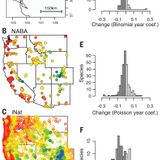RECENT ARTICLES

Fewer butterflies seen by community scientists across the warming and drying landscapes of the American West
You are currently viewing the abstract.AAAS login provides access to Science for AAAS members, and access to other journals in the Science family to users who have purchased individual subscriptions.Log in via OpenAthens.Log in with your institution via Shibboleth.Download and print this article for your personal scholarly, research, and educational use.Buy a single issue of Science for just $15 USD.Many recent studies have revealed sweeping declines in insects over the past few decades. Butterflies are no exception. Forister et al. used three different datasets, collected by both experts...…You are currently viewing the abstract.AAAS login provides access to Science for AAAS members, and access to other journals in the Science family to users who have purchased individual subscriptions.Log in via OpenAthens.Log in with your institution via Shibboleth.Download and print this article for your personal scholarly, research, and educational use.Buy a single issue of Science for just $15 USD.Many recent studies have revealed sweeping declines in insects over the past few decades. Butterflies are no exception. Forister et al. used three different datasets, collected by both experts...WW…

The influence of juvenile dinosaurs on community structure and diversity
Modern carnivore communities include species that span a range of body sizes. For example, on the African savannah, there are small species (mongooses), medium species (wild dogs), and large species (lions). This variation reflects available prey sources that best suit each group. Carnivorous dinosaur communities, however, were missing species that fall into the middle, or mesocarnivore, group as adults. Schroeder et al. looked across communities, space, and time and found that this absence appears to have been driven by the distinctive biology of dinosaurs, in which giant adults start out...…Modern carnivore communities include species that span a range of body sizes. For example, on the African savannah, there are small species (mongooses), medium species (wild dogs), and large species (lions). This variation reflects available prey sources that best suit each group. Carnivorous dinosaur communities, however, were missing species that fall into the middle, or mesocarnivore, group as adults. Schroeder et al. looked across communities, space, and time and found that this absence appears to have been driven by the distinctive biology of dinosaurs, in which giant adults start out...WW…

The gut microbiome defines social group membership in honey bee colonies
In the honey bee, genetically related colony members innately develop colony-specific cuticular hydrocarbon profiles, which serve as pheromonal nestmate recognition cues. Yet, despite high intracolony relatedness, the innate development of colony-specific chemical signatures by individual colony members is largely determined by the colony environment, rather than solely relying on genetic variants shared by nestmates. Therefore, it is puzzling how a nongenic factor could drive the innate development of a quantitative trait that is shared by members of the same colony. Here, we provide one...…In the honey bee, genetically related colony members innately develop colony-specific cuticular hydrocarbon profiles, which serve as pheromonal nestmate recognition cues. Yet, despite high intracolony relatedness, the innate development of colony-specific chemical signatures by individual colony members is largely determined by the colony environment, rather than solely relying on genetic variants shared by nestmates. Therefore, it is puzzling how a nongenic factor could drive the innate development of a quantitative trait that is shared by members of the same colony. Here, we provide one...WW…
- Total 3 items
- 1